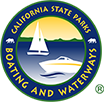
.JPG)


REPORT A SIGHTING
If you sight Brazilian waterweed, curlyleaf pondweed, Eurasian watermilfoil, coontail or fanwort, please call the Division of Boating and Waterways (DBW) at (888) 326-2822 or e-mail the Division at ais@parks.ca.gov. Include in your message the address or nearest landmark of the sighting. If possible, take photographs of the plant.
Plants that grow under the water surface (some submersed plants may have floating leaves) are known as Submersed Aquatic Vegetation (SAV). They grow in wetlands, marshes, shallow water bodies, slow moving waterways, lakes, reservoirs, and rivers. Some SAV are invasive, and if they are left unchecked, they can be a problem for boaters, agriculture and public safety. In addition, these invasive SAV can also crowd out native plants, reduce water flows, entrap sediments, obstruct waterways, and navigational channels, and clog agricultural and municipal water intakes. In California, these invasive SAV include Brazilian waterweed (Egeria densa), curlyleaf pondweed (Potamogeton crispus L.), Eurasian watermilfoil (Myriophyllum spicatum), coontail (Ceratophyllum demersum), and fanwort (Cabomba caroliniana).
CLICK HERE for more description and characteristics of Submersed Aquatic Vegetation.
In 2001, lawmakers designated the California Department of Parks and Recreation Division of Boating and Waterways (DBW) as the lead agency for controlling Egeria densa in the Sacramento-San Joaquin Delta. Recently, other species of submersed aquatic vegetation species have spread throughout the Delta requiring additional legislative treatment authority and a holistic approach to control.*
With the addition of curlyleaf pondweed (Potamogeton crispus L.), the original Egeria densa Control Program has been changed to the Submersed Aquatic Vegetation (SAV) Control Program. For more information about the SAV program, see our 2016 Annual Report.
Management and Control Methods
The SAV Control Program uses herbicide treatment as part of a strategic and adaptive Integrated Pest Management (IPM) system including herbicide treatment supported by hand-picking.
-
Herbicide Control
Approved herbicide application is our primary method of SAV control. The products we use have been approved for aquatic use by the U.S. Environmental Protection Agency and the California Department of Pesticide Regulation.
For more information about this year treatment season CLICK HERE.
-
Mechanical Control
This type of control method is not used for SAV. These plant species spread by fragmentation. Cutting the plants back exacerbates the problem, as shreds of the plants float away and re-propagate.
-
Environmental Monitoring
DBW environmental scientists and field crews monitor all treatment areas to ensure that herbicide concentrations do not exceed allowable limits or have any significant adverse impacts on the environment, agriculture, or public health. In addition, we minimize and mitigate harm to state or federal endangered, threatened, or species of special concern when SAV control is underway.
* Assembly Bill No. 2193, Chapter 2, Article 2, Section 64 amended the California Harbors and Navigation Code. Also, Assembly Bill 763 included curlyleaf pondweed and holistic control plans.
